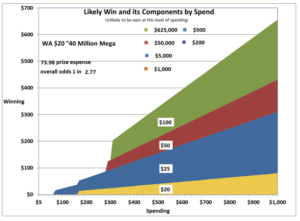
Engineering Instant Game Prize Structures
The experience of wins keeps players coming back to instant games; paying prizes in instant games is the primary operating expense of most lotteries. It is not simply a matter of paying too much or not enough - the real question is which prizes to fund.
Like many, I started by asking "what satisfies?"My first significant insight was that this is the wrong question. The right question is "what engages?" Success is getting the player to buy the next ticket.
My second significant insight was that a table showing counts and amounts of prizes (a typical way of representing a prize structure) did not communicate much about the winning experience to me, or anyone else. Consequently I developed graphic tools to visualize the winning experience. These visualizations put everyone on a equal footing to understand and discuss the play experience. Once we all understand how often wins of particular sizes are likely to happen, we can have a productive discussion about whether that is the experience we want to deliver. We are also able to recognize when there are prizes defined, whose contribution to engagement is not commensurate with their cost. Using the visual tool at the speed of discussion, we are able to quickly see the consequences of moving money within the prize structure.
I have often found it possible to modify existing prize structures to improve engagement and reduce prize cost at the same time. This sounds almost too good to be true, but Washington's Lottery committed to applying these methods across the whole instant portfolio, and has proved the benefit.
I can help your staff as an adviser and as a trainer. Given the large dollar volumes involved, saving 1% in prize cost will bring millions of dollars to the bottom line more quickly than any other incremental improvement a lottery can make. Contact me now to get started!